
설문지 조사
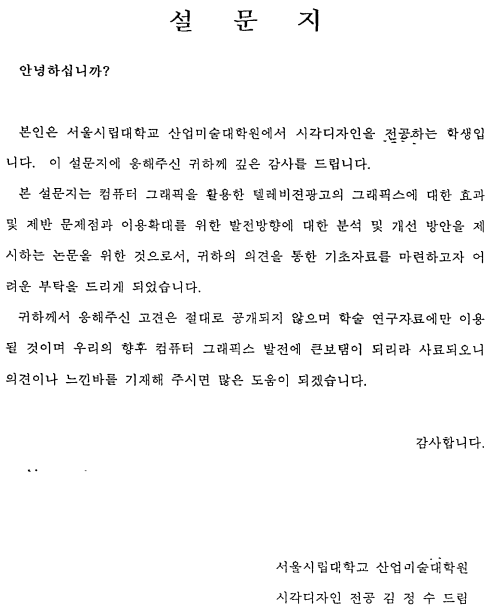

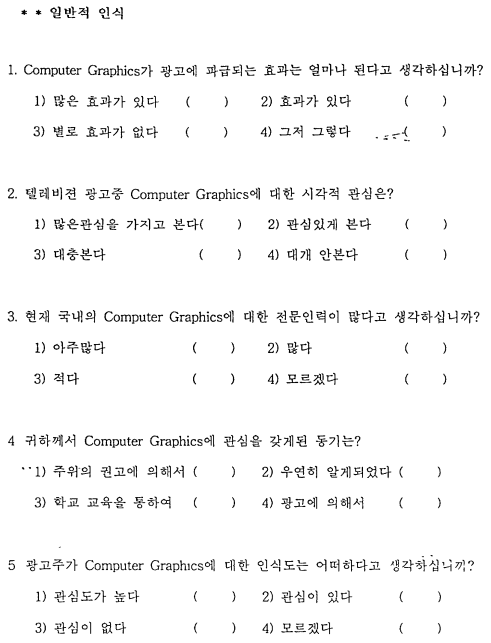
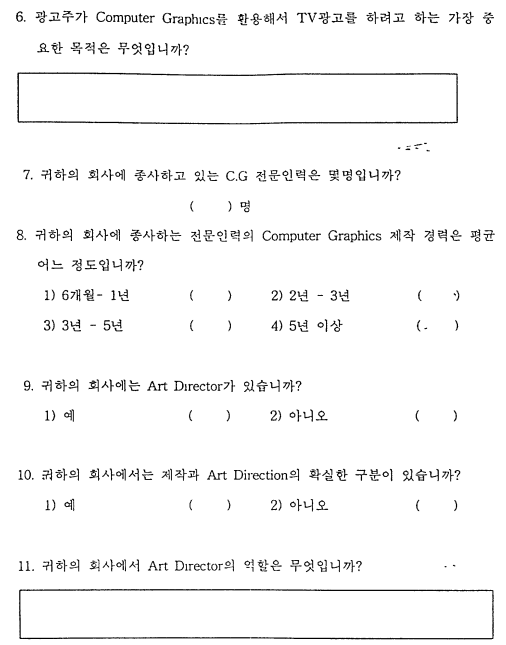
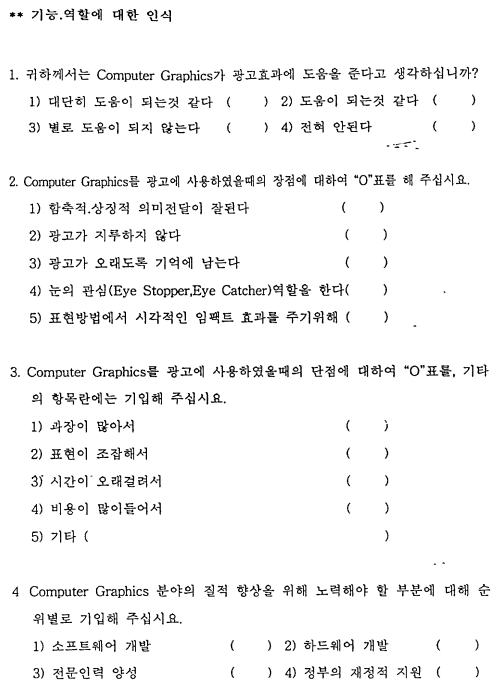
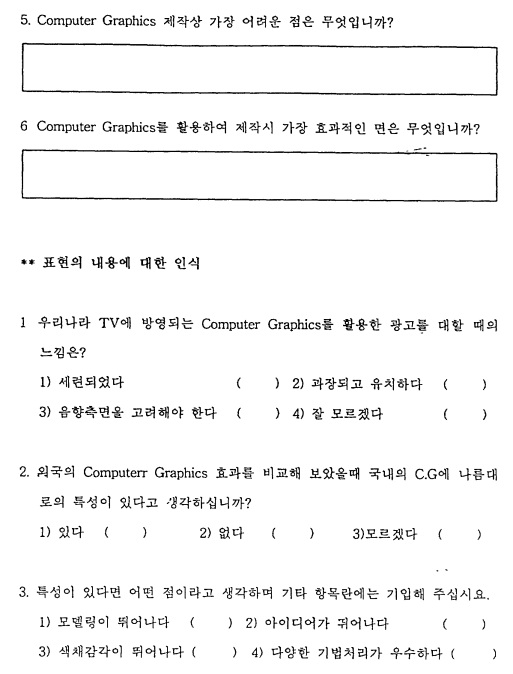
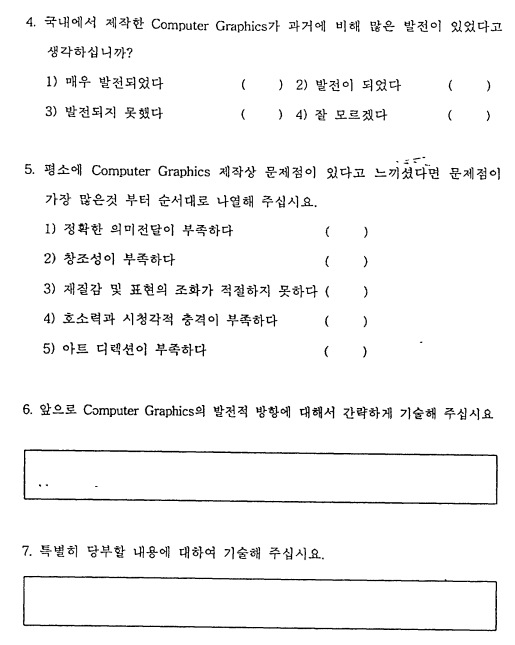
참고문헌
1. 국내문헌
(1) 단행본
김수경 · 이대윤, 「컴퓨터 그래픽스」, 1992, 디자인 신문사
김영임, 「TV제작 입문」,1993, 나남
김춘일, 「미술과 시지각」, 1992, 기린원
노용덕, 「컴퓨터 그래픽스」, 1990, 무역경영사
박선의·최호천, 「시각커뮤니케이션 디자인」, 1989, 미진사
방승혜·유택상, 「디자이너와 아티스트를 위한 컴퓨터 그래픽스」, 1991, 한국문연
신진식, 「컴퓨터 애니메이션」, 1989, 한국문헌
오두범, 「광고 커뮤니케이션」, 1993, 전예원
(2) 논 문
김동희, "한국광고 표현의 특성연구" 중앙대학교 대학원, 1992.
김은경, "TV 광고표현으로서의 컴퓨터 애니메이션", 이화여자대학교 대학원, 1993.
김인철, "CF에 나타난 소프트웨어의 활용과 그에 따른 임팩트한 표현연구", 홍익대학교 대학원, 1993.
명광주, "시각 디자인에 있어서의 Visual Scandal 표현 효과에 관한 연구", 홍익대학교 산업미술 대학원, 1987.
박혜성, "우리니라 Computer Graphics 현황연구", 상명여자대학원, 1988,
이건호, "Computer Graphics를 활용한 Television Diagrams에 관한 연구", 홍익대학교 대학원, 1992.
이재구, "영상의 특수효과에 관한 연구", 중앙대 대학원, 1991.
우수련, "TV Commercial Film에서의 Computer Animation 활용 현항에 관한 연구", 홍익대학교 산업미술 대학원, 1987.
전양덕, "컴퓨터 그래픽스에 의한 Animation에 관한 연구", 홍익대학교 산업미술대학원, 1986.
장연규, "C.G에서의 초현실주의 표현기법의 활용에 관한 연구", 홍익대학교 대학원, 1993.
차지원, "TV-NEWS의 시각 전달 효과를 위한 News Graphics에 관한 연구, 홍익대학교 산업미술 대학원, 1991.
(3) 정기 간행물
광고정보, 한국방송광고공사 1992년 3월호∼1994년 8월 호
마이크로 캐드캠, 1994년 5월∼6월 호 월간 디자인, 1993년 3월호∼1994년 5월 호 월간 COSMA, 1993년 5월 호-1994년 7월 호
2. 외국문헌
A.G.M. Pritchett: "Animation By Computer and The Film and Television Industries", CG8O, 1980.
Ayers, R., "Graphics for Television", N.J, Prentice-Hall. 1984
Dennis Harris, "Computer Graphics and Applications", 1984.
James RCaruso, Mavis E Arthur "A Beginner's Guide to Producing TV Complete Planning Techniques And Scripts to Shoot". Prentice-Hall,Inc, 1990.
John Lewell, "Computer Graphics Survey of Current Techniques and Applications)", 1985.
Joseph Deken, "Computer Image(State of the Art)", 1983.
Stan Hayward, "Computer for Animation", 1984, Focal Press
William T. Reeves· "Inbeteening For Computer Animation Utilizing Moving Point Constrains, ACM, Computer Graphics", 1981
ABSTRACT
A CASE STUDY 0F TV ADVERTISEMNENT UTILIZING COMPUTER GRAPHICS.
KIM JUNG SU(Major in visual Design Dept. of Industrial Arts Graduate School of Seoul City University)
Today's advertisement is very much responsive to the acceptance of the formative sense and attaches greater importance to visual and cubic affects than any other field of language or letters as well. Because the conveyance of information via TV has incomparably wider spreading effect by the region and class than other media and, by its character, is not selected by viewers but forced on them unilaterally it requires active acceptance of the change of the times and the development of effective method of conveyance. The first phase of the conveyance of information via TV is performed with the field based on technology. But today's reality is that it is impossible to spread desired information effectively by concentrating the eyes of the public carrying on complicated life only with a simple image reflected by TV. Advertisement is an activity to communicate with an illuminating image for the purpose of persuasion. In this sense the information of the field must be arranged and summarized in a visual language of special technique that the general public understand with ease.
For these reasons, computer graphics advancing remarkably owing to modern science now Is attracting public attention as thc only means capable of maximizing the effect of advertisement, a visual media, with Its unlimited ability of expression and Innovative capability to conveyer and process information. The coming 21st century is a high-degree information age rapidly increasing the demand for value-added information and the dependence on computer graphics will be much more increased to meet such demand.
Therefore, computer graphics will play a leading role in the future image industry and its spreading effect is expected to be great. However, the Korean computer graphics is on such a low level that it cannot meet such demand yet.
Therefore, this research is intended to maximize the visual conveyance effect of TV advertisement and contribute to the development of the local computer graphics by diagnosing where the local computer graphics is at present and seeking for its effective utilization for TV advertisement through case studies and examination of questionnaires.